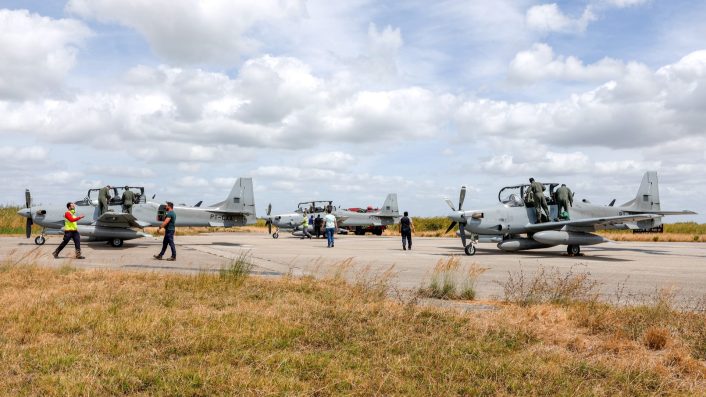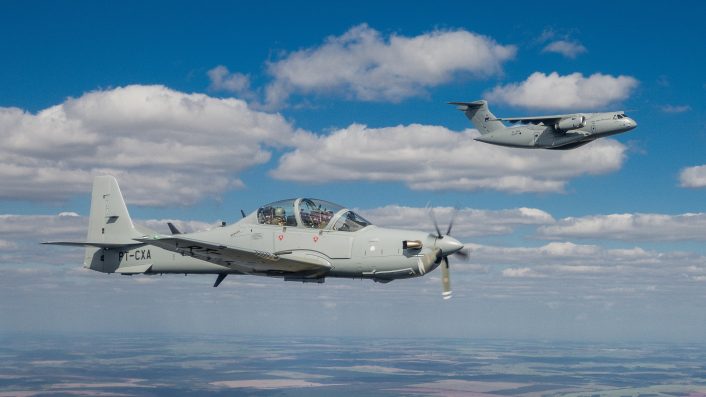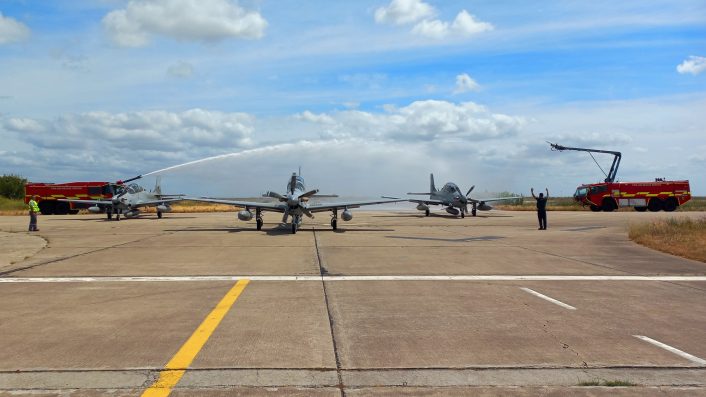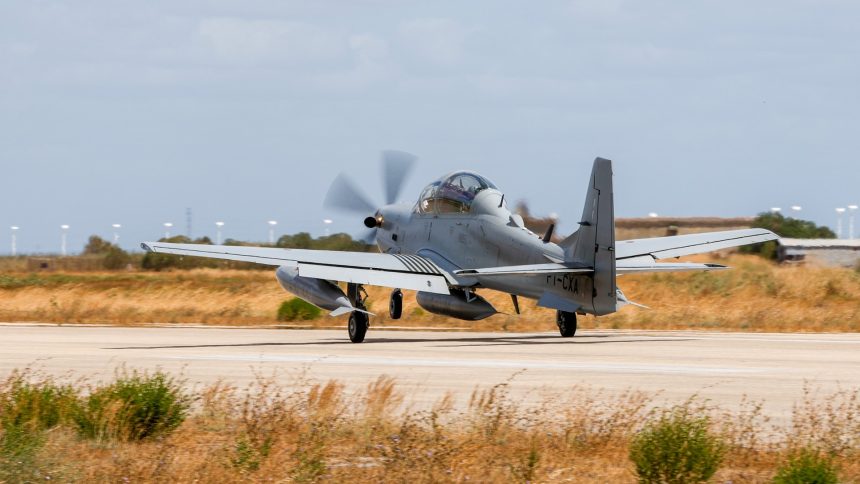Portugal receives its first A-29N Super Tucanos, which will now undergo NATO equipment integration at OGMA before entering service with the Air Force.
Portugal has received its first three Embraer A-29N Super Tucano light attack and advanced trainer aircraft, which landed at OGMA’s facilities in Alverca do Ribatejo on Aug. 31, 2025. The aircraft are the first batch of a 12-aircraft order signed in December 2024, making Lisbon the launch customer for the NATO-standard variant of the proven Super Tucano.
A highlighted by Embraer, the transfer flight from its Gavião Peixoto facility in Brazil to Portugal took place just eight months after the contract signature. The three aircraft arrived carrying long-range ferry tanks and with temporary Brazilian registrations before undergoing systems integration work at OGMA, a subsidiary of Embraer in Portugal.
A NATO-Compatible Super Tucano
The A-29N is the latest evolution of Embraer’s successful turboprop, which has been in service since the early 2000s and is operated by 22 air forces worldwide. Unlike previous versions, the A-29N is specifically tailored to NATO standards, featuring NATO-compatible avionics, communications systems, navigation equipment, and a tactical data link.

Portugal’s order, valued at around €200 million ($210 million), also includes a flight simulator, logistics support, and a package of services. The program falls under Portugal’s Close Support Aircraft initiative, one of eight major procurement priorities established in the country’s Military Programming Law, as reported by Breaking Defense.
The acquisition is particularly significant as it addresses a capability gap left by the retirement of Portugal’s Dassault/Dornier Alpha Jets in 2018. With the arrival of the A-29N, the Portuguese Air Force regains a modern advanced trainer and light attack platform, suitable for both domestic and NATO operations.
Role in Training and Operations
Lisbon intends to use the A-29Ns primarily in a training role, including advanced pilot training and support for Joint Terminal Attack Controller (JTAC) qualification. However, the platform retains its combat-proven versatility, capable of close air support (CAS), reconnaissance, armed intelligence, surveillance, and reconnaissance (ISR), and light attack missions with a range of precision-guided munitions.

Major-General João Nogueira of the Portuguese Air Force (Força Aérea Portuguesa, FAP) previously emphasized the value of the A-29N configuration, describing it as “a distinctive platform, with a configuration idealized by the Portuguese Air Force, that will prove its capability in advanced training and operational usage,” according to Embraer’s press release on occasion of the first flight in July 2025.
The robust airframe, designed to operate from unpaved or austere runways, along with low maintenance requirements and high availability, makes the type especially appealing for smaller air arms or NATO members looking for cost-effective training and light combat solutions.
OGMA’s Role and Industrial Participation
Upon arrival in Portugal, the first three A-29Ns entered OGMA’s facility for integration of NATO-specific systems before the aircraft is finally fielded by the FAP. While Embraer has not disclosed all details, the modifications are expected to include alliance-standard communications and navigation equipment, as mentioned earlier.

This work forms part of a broader push for Portuguese industrial involvement. In April 2024, Embraer signed a memorandum of understanding with local firms CEiiA, ETI, GMV, and OGMA to support development and systems integration work for the program, according to Breaking Defense.
Lisbon has highlighted this aspect as critical for strengthening its defense technological and industrial base, positioning Portuguese companies to play a larger role in NATO-related projects. A similar path was followed for the Portuguese KC-390s.
Strengthening Portugal–Brazil Defense Cooperation
The A-29N order is the second major Embraer program Portugal has committed to in recent years, following its acquisition of the KC-390 Millennium tactical transport aircraft. Portugal already operates three of a planned six KC-390s, with deliveries continuing since 2023.

After initial plans for a five-aircraft fleet, in June 2025, Portugal announced plans to acquire a sixth KC-390 and to include ten purchase options for potential government-to-government transfers to other NATO members, said Embraer. The arrival of the A-29N further deepens this strategic cooperation between Portugal and Brazil.
The acquisition of the A-29N Super Tucano reinforces FAP’s confidence in Embraer products,” stated Bosco da Costa Junior, Embraer Defense & Security’s CEO. “We are sure that these aircraft will contribute even more to the modernization of the Portuguese fleet and to broader cooperation with the local industry”
A Combat-Proven Aircraft Finds a New Home in Europe
Globally, the Super Tucano has accumulated more than 600,000 flight hours, including over 60,000 in combat, says Embraer. According to the company, this demonstrates its resilience and adaptability in operational theaters ranging from South America to Africa and the Middle East.

By selecting the A-29N, Portugal has not only modernized its training fleet but also positioned itself as the first European operator of the type. Once fully operational, the Super Tucanos are expected to enhance both the FAP’s training pipeline and its interoperability with allied forces.
As the first three aircraft undergo NATO integration at OGMA, the remaining nine A-29Ns will follow in staged deliveries. The timeline for the future deliveries has not been disclosed.









